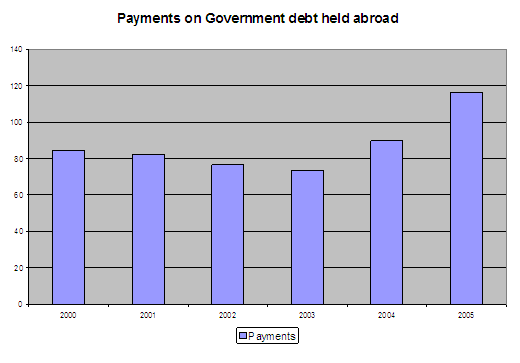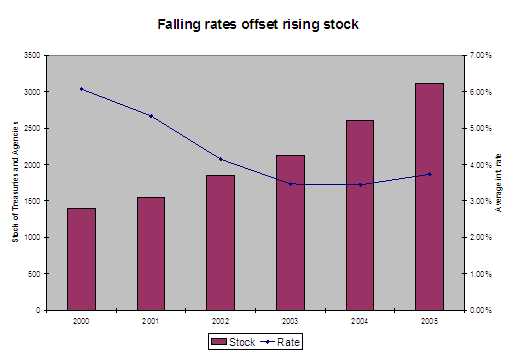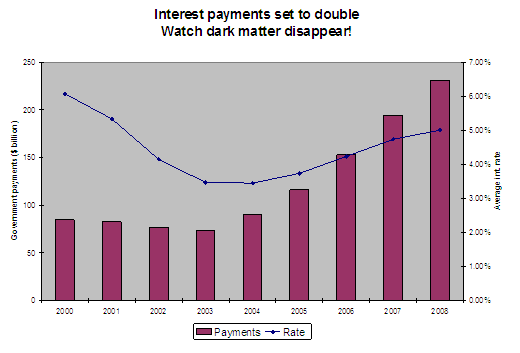Bill Cline of the IIE rightly took Nouriel and me to task (politely) for assuming that the average return on US FDI abroad would equal the average return on foreign FDI in the US in our 2004 paper on US external debt dyanmics. We didn't explicitly intend to make that assumption, but we used a common interest rate for all US external liabilities and US external assets. It makes the math easier. But, to use the current terminology, we also assumed dark matter away.
But the implied interest rate on US government debt held abroad in Cline's data always has struck me as a bit strange. He calculated it by dividing government payments in the balance of payments data by the stock of Treasuries held abroad. The resulting implied interest rate, though, seems a bit too high. I did a bit of digging, and it turns out that the interest on Agencies held abroad are counted in government payments, so the data on US government payments really should be divided by the stock of both Agencies and Treasuries held abroad, not just the stock of Treasuries.
That isn't just wonky data mining. Recalculating the implied interest rate on US government debt (including Agencies) held abroad helps to clarify some important dynamics. Interest payments on Treasuries and Agencies held abroad have been rather flat for the past few years.

Why? Falling rates have offset a rising stock of Treasuries and Agencies in foreign hands!

Alas, as we all know, interest rates are rising. And with a lag, the average interest rate on US debt should move up.
In 2006, the US needs to refinance ten year bonds issued in 96 (probably at a lower rate), five years issued in 01 (little impact), three years issued in 03 (higher rate), two years issued in 04 (higher rate) and bills from 05 (higher rate). That will push rates up.
Plus the US is taking on new debt.
And it will need to refinance more existing debt and take on new debt in 2007 and 2008.
I assumed the average interest rate would rise from 3.73% in 2005 to 4.23% in 06, 4.73% in 07 and then level off at 5% in 2008. I haven't tried to look at the exact US debt structure to do a precise estimate, but I suspect this is a realistic path. I also assume that the US continues to finance its current account deficit by selling Treasuries and Agencies to foreigners to the tune of $500 billion a year.
Both assumptions show up in the following chart.

What happens? US interest payments start to rise fast. They basically double over the next three years

Bye-bye dark matter. Actually, bye-bye dark anti-matter - to use a term coined by Matthew Higgins, Thomas Klitgaard and Cedric Tille.
The difference between the 3.72% the US paid on Treasuries and Agencies held abroad and the 5% discount rate Hausmann and Sturzenegger use to the value all flows means that the US got an "income" windfall of about $40 billion on the roughly $3.1 trillion in US Treasuries and Agencies held abroad. The US paid $115b on that debt; Hausmann and Sturzenegger say that that the US should have paid $155b. Hausmann and Sturzenegger's methodology implies the US only has around $2.3 trillion in this kind of debt, not $3.1 trillion. Or the US has $800 b in dark anti-matter.
But the US hasn't locked in that low rate forever. The dark anti-matter is going to go away.
The overall income balance should deteriorate by even more than the balance on government payments.
The US probably needs to sell $1000b of new debt a year to sustain a current account deficit of 7% of US GDP or so. I assumed $500b of that would be Agencies and Treasuries, but that still leaves $500b in private debt that the US would need to sell to foreigners every year.
US banks and firms already owe to foreign creditors about $5.5 trillion, and about $3.4 trillion of those debts look to be short-term claims whose rate should move up quickly (Wonky note: I tried to adjust the end 2004 stocks with the 2005 flows to estimate the end 2005 stocks).
Fortunately, the $4.3b trillion of US lending to the rest of the world - overwhelmding denominated in dollars -- will also reprice. And about $3.3 trillion of that is short-term, so it should reprice as fast as the $3.4 trillion short-term debt the US owes the rest of the world. That helps.
Add it all up -- the $3.1 trillion in Treasuries and Agencies foreigners own, the $5.5 trillion private US banks and US firms owe to the rest of the world, the $4.3 trillion the US has lent to the rest of the world. It turns out the US owes about $4.1 trillion to the rest of the world (net).
Over the next three years the $4 trillion net US debt position will rise to at least $7 trillion. And the interest rate on much of the existing $4 trillion will rise as existing debts need to be refinanced. So a net interest bill of roughly $140b (by my rough calculations) in 2005 will rise to $350b.
Ouch.
$150b of the increase comes from new debt (3 trillion at 5%); $60b from the repricing of existing US debt.
If the average rate should rise to 6% -- roughly the interest rate the US paid back in 2000 -- the 2008 US interest bill would reach $420b. That is more than three times the 2005 interest bill. The US external balance is potentially quite vulnerable to an interest rate shock.
My calculations assumes that the US gets what it pays on a lot of debt claims that I net out. I think that is right. But Hausmann and Sturzenegger would certainly challenge that assumption -- and I haven't yet some the leg work needed to refute their argument that the US borrows low and lends high. It doesn't seem to be true judging from the average interest payments in the past and the composition of US lending (Most US loans are to low risk/ low return kinds of places). But I still need to do a bit more work.
Moreover, some US debt finances US equity holdings abroad, since by the end of 2005, the US probably holds about $1.5 trillion more in foreign equity (FDI + portfolio equity) than foreigners hold in US equity (FDI+portfolio).
The numbers here are very rough. Still, they don't look good ...
Particularly if you think the US is paying out a lot more on FDI in the US than shows up in the US data. The "real" income balance is gonna look ugly pretty quickly.